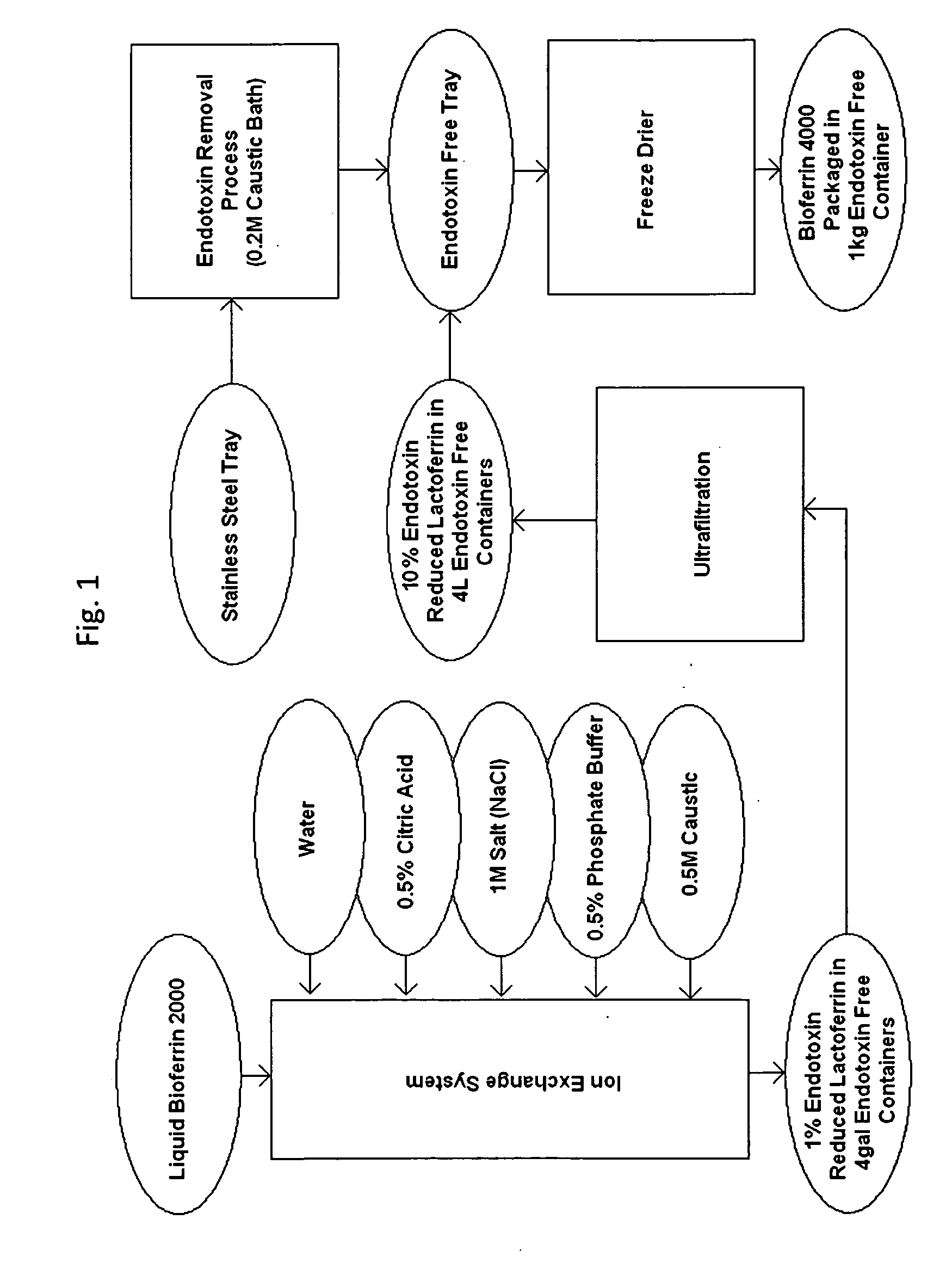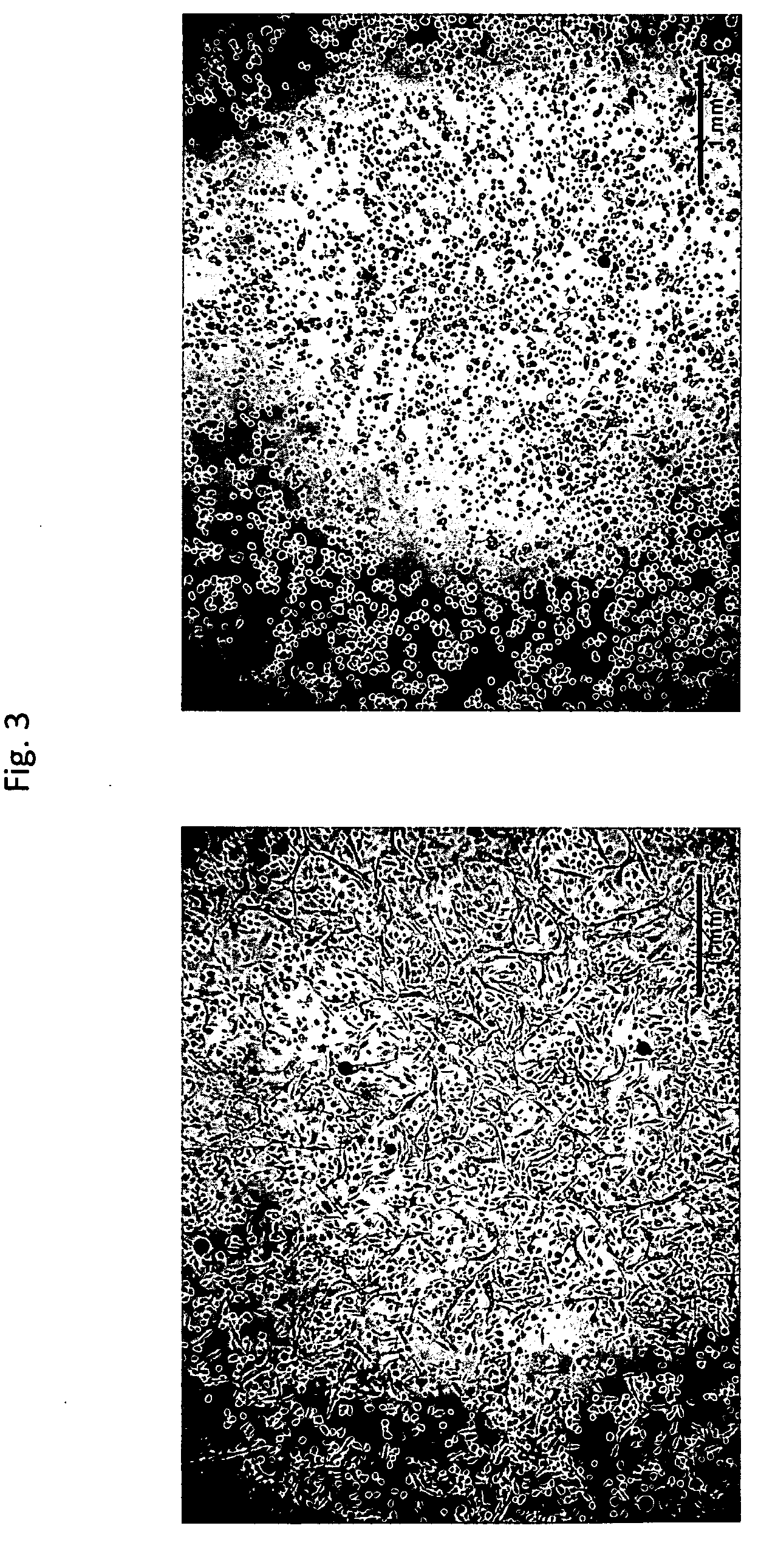Method for Removing Endotoxin from Proteins
a technology of endotoxin and protein, applied in the field of methods for removing endotoxin from proteins, can solve the problems of toxic shock, life-threatening condition, and methods that do not lend themselves to the production of large quantities of endotoxin-free compositions, and achieve low ionic strength, high ionic strength, and low ionic strength.
- Summary
- Abstract
- Description
- Claims
- Application Information
AI Technical Summary
Benefits of technology
Problems solved by technology
Method used
Image
Examples
example 1
Preparation of EFL
[0043]Ion exchange was performed as described above. Tables 2 and 3 illustrate the results obtained by the method described herein.
TABLE 2Individual Ion Exchange LotsLAL (EU / mg)(Limulus Amibocyte Lysate PlateDay / Run(Kinetic Technique) Method) 1 / 10.701 1 / 20.739 2 / 12.8 2 / 27.356 2 / 36.88 3 / 14 3 / 22.15 4 / 20.07 5 / 31.88 5 / 41.95 5 / 51.02 6 / 10.33 6 / 20.39 6 / 30.81 6 / 40.61 6 / 51.54 7 / 62.45 8 / 10.32 8 / 20.958 8 / 31.353 9 / 10.331 9 / 20.199 9 / 30.411 9 / 40.428 9 / 50.255 9 / 60.12110 / 10.2310 / 20.1210 / 30.13110 / 40.4710 / 50.25811 / 11.1411 / 24.8711 / 37.41311 / 42.37312 / 10.34913 / 10.32713 / 20.1913 / 30.20513 / 40.12513 / 50.23313 / 60.1514 / 10.29914 / 20.16214 / 30.14815 / 10.239815 / 20.13715 / 30.32315 / 40.15915 / 50.078815 / 60.09115 / 70.13716 / 11.67616 / 20.73116 / 30.80316 / 40.72416 / 51.01517 / 10.15817 / 20.419
TABLE 3Daily Average Results of Limulus Amoebocyte AsssayAverage orBatchesCompedDayProducedEU120.117260.275350.242441.315510.349660.168750.185870.179951.0151080.2911190.465
example 2
Product Comparison in Keratinocyte Scratch Assay, No Serum in Media
[0044]Primary human keratinocytes were seeded in 24-well plates and grown to 90-95% confluence. A scratch was made down the center of the well, using a 200 microliter pipet tip. Plates were washed with HEPES-buffered saline and imaged (T=0). Three hundred microliters of product (standard commercially-available bovine lactoferrin product=medium endotoxin, product produced by the method of the invention=low endotoxin) were added to the corresponding wells and cells were incubated at 37° C. at 5% CO2. At 24-hour intervals, media and product were removed by aspiration, cells were washed with buffered saline, and fresh media with product were replaced. Cells were returned to the incubator after washing and media / product change. The assay was terminated after 72 hours. Product tested comprised 1% of the low endotoxin product (EFL) in cell culture medium, 2% of the low endotoxin product (EFL) in cell culture medium, 1% of t...
example 3
Product Comparison in Cultured Primary Human Keratinocytes, Serum Added
[0047]Primary human keratinocytes were seeded in 24-well plates and grown to 70% confluence. Plates were washed with HEPES-buffered saline and imaged (T=0). Three hundred microliters of product (standard commercially-available bovine lactoferrin product medium endotoxin, product produced by the method of the invention=low endotoxin) were added to the corresponding wells and cells were incubated at 37° C. at 5% CO2. Samples tested were 1% low-endotoxin lactoferrin+culture medium, 2% low-endotoxin lactoferrin+culture medium, 3% low-endotoxin lactoferrin+culture medium, 1% medium-endotoxin lactoferrin+culture medium, 2% medium-endotoxin lactoferrin+culture medium, 3% medium-endotoxin lactoferrin+culture medium, and control (cell culture medium only). At 24 hours, media / product was removed, cells were washed, and 300 microliters of fresh medium plus 60 microliters of XTT were added. Cells were incubated for an additi...
PUM
| Property | Measurement | Unit |
|---|---|---|
| Ionic strength | aaaaa | aaaaa |
| Ionic strength | aaaaa | aaaaa |
| Ionic strength | aaaaa | aaaaa |
Abstract
Description
Claims
Application Information
 Login to View More
Login to View More - R&D
- Intellectual Property
- Life Sciences
- Materials
- Tech Scout
- Unparalleled Data Quality
- Higher Quality Content
- 60% Fewer Hallucinations
Browse by: Latest US Patents, China's latest patents, Technical Efficacy Thesaurus, Application Domain, Technology Topic, Popular Technical Reports.
© 2025 PatSnap. All rights reserved.Legal|Privacy policy|Modern Slavery Act Transparency Statement|Sitemap|About US| Contact US: help@patsnap.com



